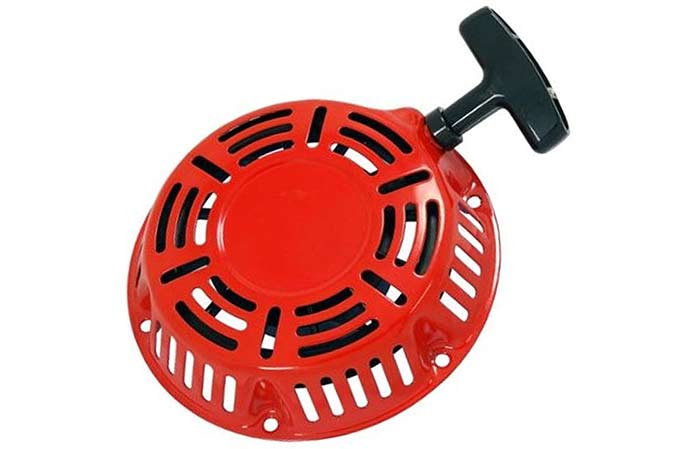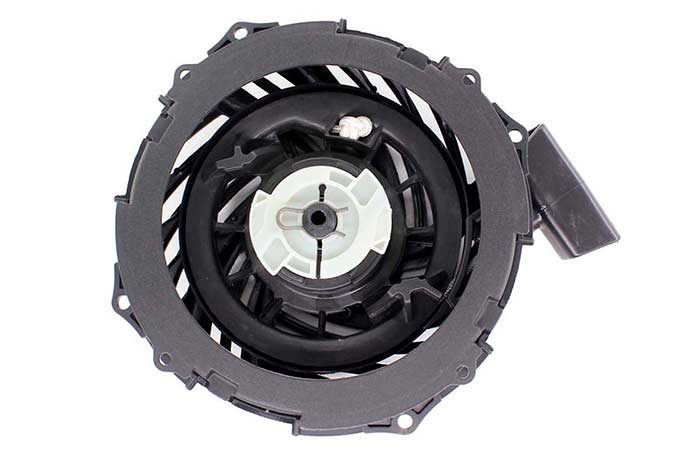Your generator has a pull cord which is one way of starting the generator. In fact, a majority of the generators on the market use this pull cord with a few using a key, switch or remote device. The pull cord has a T-shaped handle which juts outside of the pull cord hub and makes part of the starter recoil setup.
In normal operation, the pull cord should come out when pulled and retract when released. This is made possible by a combination of springs that pull back the pull cord after being pulled out. In some cases, however, the pull cord may fail to retract. This prevents it from being used to start the generator again.
In this guide, we look at what causes such a scenario and how to fix it. The causes and solutions offered apply to both new and used generators although a lot of them affect used ones. This is because they’re from the wear and tear of the parts which won’t be the case for the new generator.

The reasons your pull cord can’t retract back into the recoil hub include the following:
Damaged pulley
The pull cord and the recoil spring are housed in a pulley on the side of the generator. The pull cord is wound around the outside of the pulley in one direction. A wound recoil spring is then mounted inside the pulley. This setup ensures that pulling on the pull cord unwinds the pulley and the recoil spring. At the end of the pull, the recoil spring winds itself back and pulls the cord back around the pulley.
A broken or cracked pulley won’t be effective at ensuring the recoil spring maintains its tension and retracts the pull cord. The pull cord can also get stuck in the crevices created by the broken parts. In some cases, the cracks can cut the pull cord.
Solution
You’ll need to inspect the integrity of the pulley by removing the starter and checking any damage on its parts. If it is broken or cracked, you need to replace it with a new one in the following steps:
- Pull the pull cord completely out of the pulley.
- Insert a screwdriver in the pulley to lock it in place.
- Remove the rope from the pulley then release the recoil spring by releasing the screwdriver inserted in the previous step.
- Remove the friction plate by loosening the center bolt.
- Remove the old pulley then replace it with the new one making sure it’s properly aligned with the housing post.
- Rotate the pulley to tighten the recoil spring then, reinserting the screwdriver to lock the pulley, attach the rope to the pulley. Let the recoil spring to slowly wind up the rope into the pulley before reinstalling the cover.
Try restarting the engine while observing the behavior of the pull cord.
Problems with the pull cord
The pull cord, while made of high-quality materials, eventually gets old and wears out. The rope is fed into the starter housing and is attached to the pulley. With the repeated starting of the engine, it gets to wear out due to the friction against the parts of the pulley.
In some other cases, the rope will be simply tangled thus forming a knot which prevents it from properly retracting into the pulley. The chances of this occurring inside the pulley are quite low given that there’s only enough space for the rope to go in and out. It can occur on the outside when the rope has been pulled out with the knot being larger than the entry into the pulley.
Solution
If it’s a case of a tangled rope, pulling it out some more then undoing the knot then letting go will solve it. If the rope is old and frayed, you’ll need to first buy a new one then follow these steps:
- Remove the generator’s starter to access the rope inside it.
- Pull out the rope to access the knot used to tie it to the pulley.
- Lock the pulley into place by inserting a screwdriver inside it. Make sure it doesn’t unwind since you’ll be needing the end with the knot.
- Cut off the knot of the old rope then replace it with the new rope making a small and tight knot with it.
- Release the pulley by pulling out the screwdriver while holding unto the rope. The recoil spring should pull the new cord inside it. Pull it out slowly then release to gauge if it works correctly this time.
- Put back the covers of the pulley and the starter then start the generator engine.
This should solve the issue of the pull cord not retracting when pulled out.
Malfunctioning recoil spring
The recoil spring is what retracts the pull cord back into the starter after pulling on it during the starting phase of the generator. It’s what enables the recoil starter to be used over and over again.
When this spring fails such as getting worn out and losing its tension, getting stuck or being broken, the pull cord won’t be retracted into the starter. If it’s a sudden problem, it could be that the recoil spring is just stuck or has come off the pulley. If, on the other hand, you’ve been noticing more and more of the rope remaining outside the pulley hub, it means the recoil spring has been losing its tension.
Solution
You should examine the recoil spring to establish the cause of the issue. This can be done in the following steps:
- Remove the starter from your generator to access the recoil spring and the pulley.
- Remove the bolt in the center followed by the cap and the pulley on the starter housing. You can then access the recoil spring and examine it. If it’s stuck, you simply undo it. If the spring is uncoiled, you can recoil it again.
- If broken, you’ll need a new one. Attach the new recoil spring into the slots provided on the pulley while making sure it’s held properly. The hooks should be bent properly to reduce the chances of the spring coming off.
- Start by removing the starter rope then attaching one end of the spring on the pulley.
- While keeping the spring inside the pulley, wind the spring until the other end reaches the next attachment point.
- Reinstall the center screw and its cap to fasten the pulley to the housing of the starter.
- Rotate the pulley to re-tension the recoil spring then let it go to check the direction it winds and unwinds from.
- Wind up the recoil spring to create tension in it. This can be done by turning the pulley in the direction opposite to the unwinding of the spring. Essentially, you should be pulling the spring apart with your motions on the pulley. When the spring is fully distended, insert a screwdriver into it to lock it into place.
- Insert the pull cord into the starter housing while making a small and tight knot to hold it in place.
- Hold unto the pull cord then remove the screwdriver before letting go of the cord. It should be retracted back into the starter housing.
This way, the new spring should work fine. Make sure you get a quality spring as it may easily lose its tension if it’s of a poor quality.
Broken or worn-out friction (drive) plate
Inside the starter is a series of interlinked parts one of which is the friction plate or driver plate. This plate is usually under a lot of friction and may thus wear out or even break. With some of them being made of plastic, they’re not that long-lasting. If broken or worn out, the pull cord may not move in and out of the pulley freely and may even get stuck either inside or when pulled out.
Solution
To check this part of the starter, you’ll have to remove the starter. If it’s broken, you’ll likely see it straight away. If not, try pulling the cord while checking how the parts behave, if you hear a funny grinding noise, the plate will be worn out.
Remove the center bolt then the cap of the pulley system to remove the plate and check it. If it’s not its absolute best, find a new one for replacement. After replacing it, test the pull cord to determine if it flows freely or not before reinstalling the other parts of the starter.
You should also check for dirt and debris inside the pulley system which may make the pull cord stuck. If you find any, clean it with a soft brush and blow air into it to eliminate the dirt.
Malfunctioning clutches
Some generator models use clutches instead of spring-loaded pawls for the same reason of retracting the pull cord after pulling it out during the starting phase. This clutch setup makes use of ball bearings to remain free and move in either direction.
If the clutch gets stuck, the pull cord will also get stuck inside or outside the pulley. This is because these generators still have the pulley, recoiler and rope inside the starter just like the others.
Solution
For a stuck or broken clutch, you’ll need to dig into the engine in the following steps:
- Start by removing the starter and fan shroud in order to access the clutch.
- Check for any damage or dysfunctional ball bearings.
- Remove the clutch from the generator with a pry bar. Be careful not to damage it.
- You can then replace the damaged part before reinstalling the starter and other parts.
These steps should fix the issue.
You can be sure that one of these issues are behind your generator’s pull cord not working properly.
More Generator How-tos & Hacks
- Generator Won’t Start (New & Used): Causes, Troubleshooting & Fixes
- How to Start a Generator: New, Used, With/Out Pull Cord
- Generator Won’t Stay Running: Causes & Fixes
- Generator Running Rough & Not Smoothly-Causes + Fixes
- How to Connect /Hook Generator to House without Transfer Switch
- How to Change Oil in Generator-Step by Step
- How to Clean Generator Air Filter & Housing
- How to Fix an Overloaded Generator
- How to make a Generator Quiet as a Cricket for Camping
- 15+ ways to Secure Portable Generators from Theft & Damage
- Portable Generators Safety Tips Checklist
